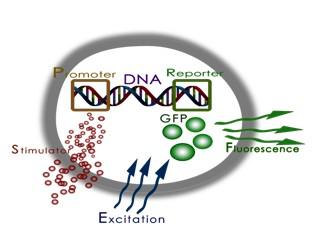Bacterial Biosensor
Whole-cell biosensors harness the ability of living cells to continuously monitor their microenvironment, and respond to local environmental changes by expressing specific gene sets. Among whole-cell sensor systems, bacterial-based ones are particularly attractive, since such cells can be genetically "tailored" to respond to almost any known type of chemical and physical or biological stress. The response of the bacteria may be manifested in different ways including the generation of an electrical charge, a luminescent signal and, most often, by fluorescence. As such, each bacterium can be regarded as a miniscule laboratory that can detect the presence of a specific chemical, and report its findings by producing an optical or an electrical signal. Moreover, bacterial biosensors can be operated in arrays to sample different substances that may be present in the same sample (e.g. different pollutants in water supply systems). Here, a large family of well-defined genetically engineered bacteria is fixed onto a mapped grid, and exposed to an unknown sample. The analysis of the response of the entire array provides a detailed characterization of the sample. Using this principle, an increasingly large number of applications are being developed in diverse areas, ranging from environmental monitoring to homeland security and food safety.
Of special interest are the fluorescent bacterial biosensors (FBB). These are based on the fusion between two elements: (i) A sensing element - a gene promoter activated in response to the presence of the substance that the bacteria was genetically engineered to sense; (ii) A reporting element - reporter genes expressed in response to the activation of the promoter genes and which initiate a series of biochemical reactions leading to the synthesis of a fluorescent molecule. As a result of this fusion, a dose-dependent fluorescent response appears upon exposure to the target chemical. A schematic illustration of a fluorescent bacterial biosensor is presented in Figure 1.

Figure 1: Schematic Illustration of Fluorescent bacterial biosensor.
A scheme for a smart fluorescent bacterial biosensor array (FBBA) which enables parallel sampling of the responses of an entire array with one photomultiplier tube (PMT) was developed at the OECL (U.S. Patent 8,198,606(B2) (2012) and [REF9]). The underlying principle of the scheme is to convert the spatially distributed signals from all the elements in the array to temporally distributed frequency multiplexed signals at the output of the photodetector. In addition, a scheme for standoff detection of buried landmines and explosive charges based on fluorescent bacterial biosensors is also developed at the OECL. The scheme combines the single sensor (the FBB) that is in contact with the suspicious area, with a detection apparatus that detects the emitted fluorescent signal from a distance. More details can be found here.

